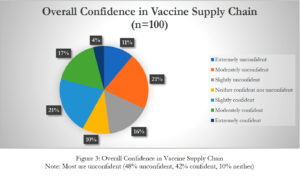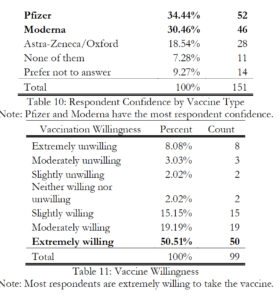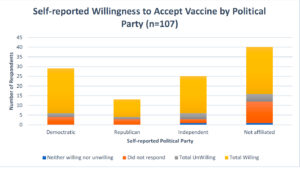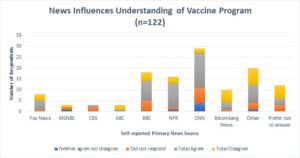How Confident is the U.S. in the Vaccine Roll-out Plan?

Professor Dan Finkenstadt and I have completed a recent analysis of relative attitudes towards the COVID vaccine’s effectiveness and distribution plan. This survey was conducted over the last four weeks, with a diverse population. The sample included a raw diverse set of respondents in terms of race, and the distribution of higher education and income were slightly on the higher end. In terms of political affiliation, Republicans were least represented in the sample. Overall, there was a good mix of respondents from technical, professional, government/military, healthcare, education, manufacturing and transportation industries with solid experience (a range of 8-31 years experience.)
What does this sample of respondents tell us about their confidence in the vaccine? Overall confidence in the vaccine is mixed, and is completely across the board. Only 4% of our sample expressed that they were extremely confident, with most respondents in the moderately confident, slightly confident, or slightly unconfident categories; the population is still in a wait-and-see mode.

A significant amount of the population (about 30-40%) have a lack of confidence that the vaccine roll-out is going well. The greatest lack of confidence is in the “Plan”, “Source” and “Deliver” phases of the vaccine. This is surprising given the volume of discussion around the manufacturing capacity, or “Make”, issues, given the volume of discussion around the manufacturing capacity issues of Pfizer, Moderna, J&J, and Astra Zeneca. What we are seeing is perhaps a shift as it has become clear that enough capacity exists in the delivery phase, but that production and shortages of raw materials are problematic. This is a very good indicator–and reflects much of the most recent news that suggests major shortages of raw material, fill finish capacity, and other constraints will be imminent. At this rate, 2022 is, in my estimation, a best-case timeframe for administering both doses of the vaccine.

Overall, the greatest confidence in the vaccine manufacturers are for the Pfizer and Moderna vaccine. Less confidence exists in the others, and 7% of our sample indicates that they don’t feel confident in taking any of the vaccines. This may be for a variety of reasons, including the expedited schedule for the roll-out. However, about 84% of the population indicates that they are willing to take the vaccine, and 50% show that they are extremely willing to take the vaccine, suggesting that many are anxiously awaiting the vaccine.
An important finding is that the confidence and willingness to take the vaccine is NOT influenced by the respondent’s political party. Both Republicans, Democrats, and independents in our sample had a majority that were totally willing to take the vaccine. This is important, as it shows that the vaccine willingness has less of a party effect than many of the news outlets are putting out right now. Many “news story lines” are representing that Republicans do not have confidence in the vaccine right now. This data does not bear this out. In fact, the majority of Republicans disagree that their party affiliation influenced either their willingness or understanding of the vaccine.

A more important contributing factor that seems to influence people’s willingness to take the vaccine involves the primary news source of an individual. We all know by now how different news channels have different biases, which seem to have a strong influence on people’s vaccine willingness. As shown in our analysis below, the watchers of CNN, NPR , Fox News and the BBC most agree that their choice of news media strongly influenced their understanding of the vaccine program. Viewers’ confidence in the vaccine is also impacted by the news source of choice. Viewers of the BBC and Bloomberg were most influenced by their news source to take the vaccine, although the reason for this is not clear.

We will be following up this blog with other analyses of our vaccine survey, and will be sharing other insights going forward.


